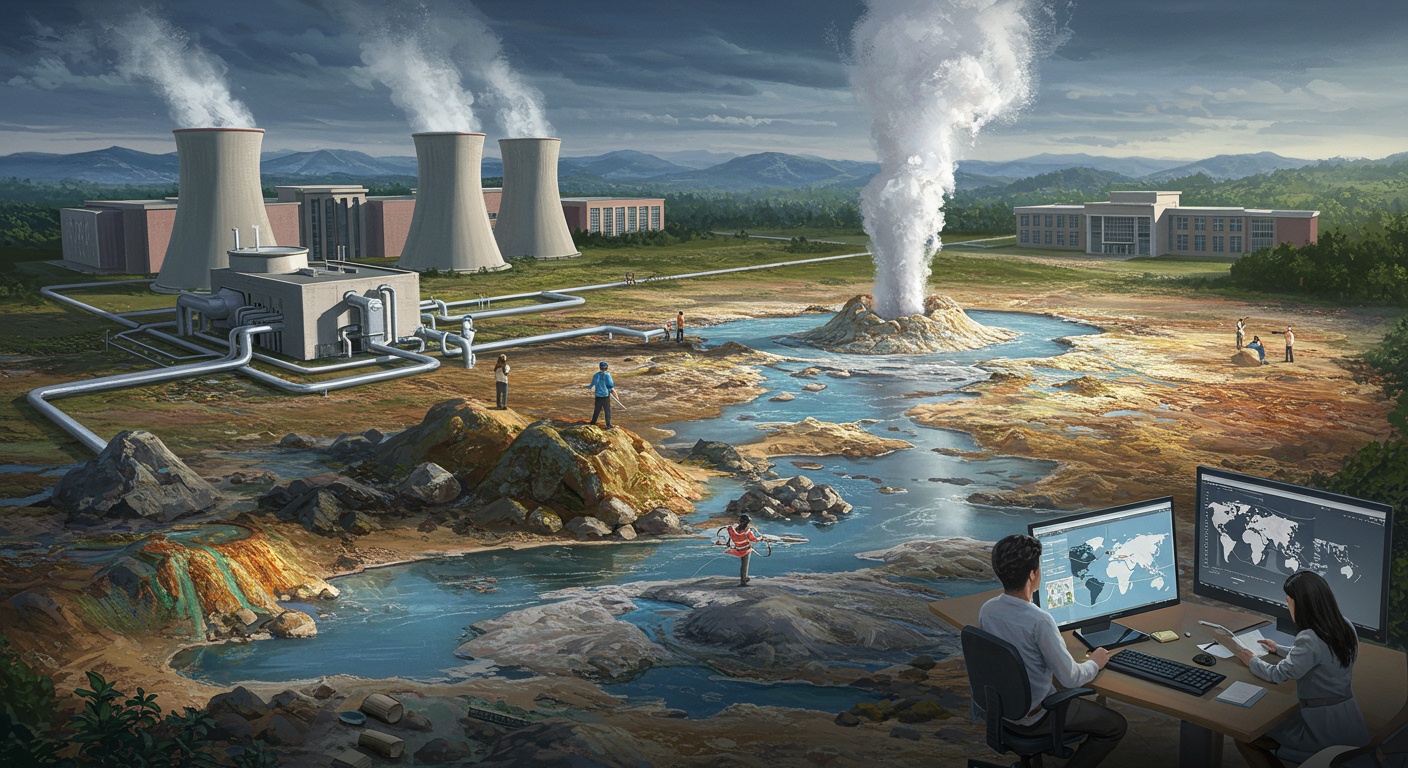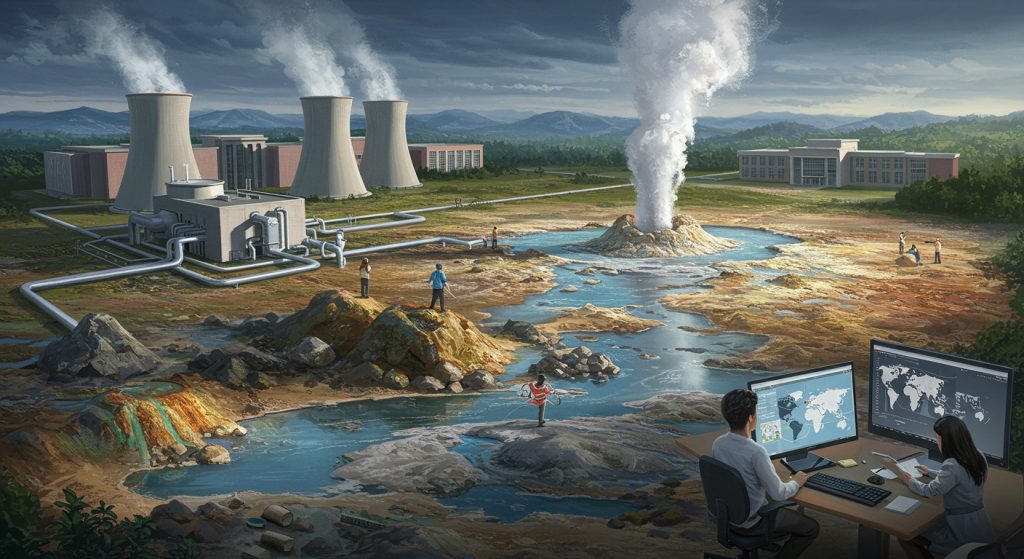Geothermal energy, a stable baseload renewable resource, is poised for significant expansion, especially with advancements in Enhanced Geothermal Systems (EGS). But, realizing its full potential requires overcoming challenges in resource exploration, drilling efficiency. Reservoir management. Leading universities are at the forefront of this innovation, pioneering research into advanced geophysical imaging techniques like full waveform inversion to better characterize subsurface formations. They are also developing novel drilling technologies, such as closed-loop systems, to reduce costs and environmental impact. Moreover, cutting-edge research focuses on optimizing reservoir stimulation and heat extraction for sustainable energy production. Discover the universities driving these breakthroughs and shaping the future of geothermal energy.

Understanding Geothermal Energy: A Primer
Geothermal energy, derived from the Earth’s internal heat, is a sustainable and reliable resource with the potential to significantly reduce our reliance on fossil fuels. Unlike solar or wind power, geothermal is available 24/7, regardless of weather conditions. It harnesses the heat from the Earth’s core, which is constantly replenished by radioactive decay. This heat manifests in various forms, from shallow ground temperatures suitable for geothermal heat pumps to high-temperature reservoirs deep underground that can generate electricity. Geothermal resources are categorized into several types:
- Hydrothermal Resources: These are the most commonly exploited resources, featuring reservoirs of hot water and steam trapped in permeable rock formations. These reservoirs can be accessed by drilling wells and bringing the hot water or steam to the surface to power turbines.
- Enhanced Geothermal Systems (EGS): EGS technology aims to create artificial geothermal reservoirs in areas with hot, dry rocks. This involves fracturing the rock to create permeability and then circulating water through the fractures to extract heat. EGS expands the geographic availability of geothermal energy.
- Geothermal Heat Pumps (GHPs): GHPs utilize the relatively constant temperature of the shallow ground to heat and cool buildings. They circulate a fluid through underground pipes, extracting heat in the winter and dissipating heat in the summer.
- Direct Use Applications: Geothermal energy can also be used directly for various applications, such as heating greenhouses, aquaculture ponds. Industrial processes.
The technologies involved in harnessing geothermal energy include:
- Drilling Technologies: Advanced drilling techniques are crucial for accessing geothermal reservoirs efficiently and cost-effectively. This includes directional drilling, which allows for multiple wells to be drilled from a single location. Advanced drill bit designs that can penetrate hard rock formations.
- Power Plant Technologies: Different types of power plants are used to convert geothermal heat into electricity, including:
- Dry Steam Plants: These plants directly use steam from the geothermal reservoir to turn turbines.
- Flash Steam Plants: These plants convert hot water from the reservoir into steam by reducing the pressure, which then drives turbines.
- Binary Cycle Plants: These plants use a secondary fluid with a lower boiling point than water, which is heated by the geothermal water and used to drive turbines. Binary cycle plants can operate with lower temperature geothermal resources.
- Heat Exchangers: Heat exchangers are used to transfer heat from the geothermal fluid to the working fluid in binary cycle plants or to directly heat water for district heating applications.
- Pumps and Compressors: Pumps are used to circulate fluids through geothermal systems, while compressors are used to increase the pressure of steam for power generation.
Leading the Charge: Top Universities for Geothermal Research
Several universities worldwide are at the forefront of geothermal energy research and development. These institutions offer comprehensive programs, cutting-edge facilities. Expert faculty dedicated to advancing geothermal technologies. Here are some of the leading universities:
- Stanford University (USA): Stanford’s Geothermal Program, within the Department of Energy Resources Engineering, is renowned for its research on enhanced geothermal systems (EGS), reservoir modeling. Geothermal exploration. They have a strong focus on developing innovative techniques to unlock the vast potential of EGS resources. Stanford hosts the Stanford Geothermal Workshop, a leading international conference in the field.
- University of California, Berkeley (USA): UC Berkeley’s research in geothermal energy spans multiple departments, including Earth and Planetary Science, Civil and Environmental Engineering. Mechanical Engineering. Their work focuses on geothermal resource assessment, geochemistry. The development of sustainable geothermal practices.
- University of Auckland (New Zealand): New Zealand, with its abundant geothermal resources, is a global leader in geothermal energy development. The University of Auckland’s Geothermal Institute is a world-renowned center for geothermal research and education. They offer a comprehensive range of programs, from undergraduate to doctoral level. Conduct research on all aspects of geothermal energy, from resource exploration to power plant design.
- Reykjavik University (Iceland): Iceland, another geothermal powerhouse, boasts Reykjavik University, which offers specialized programs in geothermal engineering and science. The university collaborates closely with the Icelandic energy sector and conducts research on geothermal reservoir management, power plant optimization. The utilization of geothermal resources for various applications.
- Delft University of Technology (Netherlands): Delft University of Technology (TU Delft) in the Netherlands is increasingly focused on geothermal energy, particularly in the context of urban heating and cooling. Their research focuses on the development of innovative geothermal systems for densely populated areas, including the use of shallow geothermal resources and the integration of geothermal energy with other renewable energy sources.
- Kyushu University (Japan): Japan, a country with significant volcanic activity, has a long history of geothermal energy utilization. Kyushu University’s research in geothermal energy focuses on resource exploration, reservoir characterization. The development of advanced geothermal technologies. They are particularly interested in developing technologies to utilize geothermal resources in volcanic areas.
These universities attract top students and researchers from around the world, fostering a collaborative environment that drives innovation in the geothermal energy sector. Their research contributes to the development of more efficient, sustainable. Cost-effective geothermal technologies.
Deep Dive: Research Focus Areas
The universities listed above are involved in a wide range of research activities related to geothermal energy. Some of the key focus areas include:
- Enhanced Geothermal Systems (EGS): EGS research aims to unlock the potential of vast geothermal resources that are currently inaccessible. This involves developing techniques to fracture hot, dry rocks and create artificial geothermal reservoirs. Research in this area focuses on:
- Fracture Modeling: Developing computer models to simulate the creation and behavior of fractures in underground rock formations.
- Stimulation Techniques: Investigating different methods for stimulating fractures, such as hydraulic fracturing and thermal stimulation.
- Reservoir Characterization: Developing techniques to characterize the properties of EGS reservoirs, such as temperature, permeability. Fluid flow.
- Geothermal Reservoir Management: Effective reservoir management is crucial for ensuring the long-term sustainability of geothermal resources. Research in this area focuses on:
- Reservoir Modeling: Developing computer models to simulate the behavior of geothermal reservoirs and predict their response to different operating conditions.
- Tracer Testing: Using tracer chemicals to track the flow of fluids through geothermal reservoirs and identify preferential flow paths.
- Injection Strategies: Optimizing injection strategies to maintain reservoir pressure and enhance heat recovery.
- Advanced Drilling Technologies: Reducing the cost of drilling is essential for making geothermal energy more competitive. Research in this area focuses on:
- Directional Drilling: Developing techniques for drilling multiple wells from a single location to access larger geothermal resources.
- Advanced Drill Bit Designs: Designing drill bits that can penetrate hard rock formations more efficiently.
- Real-Time Drilling Monitoring: Developing sensors and software to monitor drilling parameters in real-time and optimize drilling performance.
- Geochemistry and Geophysics: Understanding the chemical and physical properties of geothermal systems is crucial for resource exploration and management. Research in this area focuses on:
- Geochemical Analysis: Analyzing the chemical composition of geothermal fluids to identify potential scaling and corrosion problems.
- Geophysical Surveys: Using geophysical techniques, such as seismic surveys and electromagnetic surveys, to image the subsurface and identify geothermal resources.
- Mineralogical Studies: Studying the mineral composition of geothermal rocks to grasp the processes that control heat transfer and fluid flow.
- Direct Use Applications: Exploring innovative ways to utilize geothermal energy directly for heating, cooling. Industrial processes. Research in this area focuses on:
- District Heating Systems: Designing and optimizing district heating systems that use geothermal energy to heat multiple buildings.
- Agricultural Applications: Developing geothermal-based systems for heating greenhouses and aquaculture ponds.
- Industrial Processes: Integrating geothermal energy into industrial processes, such as food processing and chemical production.
Real-World Applications and Impact
The research conducted at these universities has a significant impact on the real-world application of geothermal energy. Here are some examples:
- Enhanced Geothermal Systems (EGS) Development: Research at Stanford and other universities has contributed to the development of EGS projects around the world. For example, the EGS demonstration project at Newberry Volcano in Oregon utilizes techniques developed through university research to create an artificial geothermal reservoir.
- Geothermal Power Plant Optimization: Research at the University of Auckland and Reykjavik University has led to improvements in geothermal power plant design and operation. This has resulted in increased efficiency and reduced emissions from geothermal power plants worldwide.
- Geothermal Heat Pump (GHP) Adoption: Research on GHP technology has contributed to the increased adoption of GHPs for residential and commercial heating and cooling. The U. S. Environmental Protection Agency (EPA) recognizes GHPs as one of the most energy-efficient and environmentally friendly heating and cooling technologies available.
- Sustainable Geothermal Practices: Research on geothermal reservoir management has helped to ensure the long-term sustainability of geothermal resources. This includes developing techniques to prevent reservoir depletion and minimize environmental impacts.
A personal anecdote: I once visited a geothermal power plant in Iceland that was designed and operated using technologies developed at Reykjavik University. I was impressed by the plant’s efficiency and its minimal environmental footprint. It was a testament to the power of university research to drive innovation in the geothermal energy sector.
Comparing University Approaches
While all the mentioned universities contribute significantly to geothermal research, their approaches and strengths may differ. Here’s a comparative overview:
| University | Focus Areas | Strengths | Potential Drawbacks |
|---|---|---|---|
| Stanford University | EGS, Reservoir Modeling, Geothermal Exploration | Strong industry connections, advanced simulation capabilities | High tuition costs, competitive admissions |
| University of California, Berkeley | Geothermal Resource Assessment, Geochemistry, Sustainable Practices | Interdisciplinary approach, strong focus on sustainability | Less specialized geothermal engineering program |
| University of Auckland | All aspects of geothermal energy, from exploration to power plant design | Extensive field experience, strong ties to the New Zealand geothermal industry | Geographically isolated, specific focus on New Zealand geothermal resources |
| Reykjavik University | Geothermal Engineering, Reservoir Management, Power Plant Optimization | Close collaboration with Icelandic energy sector, specialized geothermal programs | Smaller university, limited research funding compared to larger institutions |
| Delft University of Technology | Urban Geothermal Systems, Shallow Geothermal Resources, Integration with Renewables | Focus on urban applications, strong engineering expertise | Relatively new geothermal program, limited experience with high-temperature resources |
| Kyushu University | Resource Exploration in Volcanic Areas, Reservoir Characterization, Advanced Geothermal Technologies | Expertise in volcanic geothermal systems, strong ties to the Japanese energy sector | Language barrier for international students, specific focus on Japanese geothermal resources |
Choosing the right university for geothermal research depends on your specific interests and career goals. Consider the university’s research focus, faculty expertise, available resources. Location when making your decision. A university with robust engineering programs and active research can provide a huge benefit to your future.
Actionable Takeaways for Aspiring Geothermal Researchers
If you’re interested in pursuing a career in geothermal energy research, here are some actionable takeaways:
- Develop a strong foundation in science and engineering: Geothermal research requires a solid understanding of geology, physics, chemistry. Engineering principles.
- Gain hands-on experience: Participate in research projects, internships, or field work to gain practical experience in geothermal energy.
- Network with professionals in the field: Attend conferences, workshops. Seminars to connect with researchers, engineers. Industry professionals.
- Choose the right university: Research different universities and select a program that aligns with your interests and career goals.
- Stay up-to-date on the latest developments: The geothermal energy sector is constantly evolving, so it’s crucial to stay informed about the latest research, technologies. Policies.
By following these steps, you can increase your chances of success in this exciting and rapidly growing field. Geothermal energy offers a promising pathway to a sustainable energy future. Researchers are playing a crucial role in unlocking its full potential.
Conclusion
The journey towards harnessing geothermal energy is accelerating. The universities highlighted are at the forefront. We’ve explored institutions pushing boundaries in Enhanced Geothermal Systems (EGS), advanced drilling techniques. Sustainable resource management. Thinking like an expert, I’ve observed that a common pitfall is focusing solely on the technical aspects while overlooking community engagement and environmental impact assessments. Best practices include interdisciplinary collaboration, incorporating real-time data analysis. Actively seeking partnerships with industry leaders. My personal insight? Don’t underestimate the power of networking! Attend geothermal conferences, connect with researchers on LinkedIn. Seek mentorship from experienced professionals. The field is rapidly evolving with advancements in machine learning for resource exploration and closed-loop systems for enhanced efficiency. Embrace these changes, stay curious. Contribute to a cleaner, more sustainable energy future. Your work could literally power the world!
More Articles
BSc Computer Science: Building a Future in Blockchain and Web3 Development
BSc Computer Science: Trending Job Opportunities in the Next 5 Years
BSc Computer Science: Exploring Emerging Careers in Artificial Intelligence
Innovative Research At IIT: How Faculty Shape The Future
FAQs
So, what exactly makes a university a ‘hotspot’ for geothermal energy research?
Good question! It’s a mix of things. Think strong geology and engineering departments, dedicated research centers, funding opportunities, and, importantly, faculty who are rockstars (pun intended!) in the geothermal field. Proximity to actual geothermal resources is a big plus too.
Okay, that makes sense. But can you give me a real example? Like, what’s one university that consistently pops up when we talk about geothermal?
Definitely! The University of Iceland is a classic example. Iceland is practically built on geothermal energy, so they have decades of experience and top-notch facilities. Their research is world-renowned.
Are we talking just Iceland here, or are there good options closer to home (assuming ‘home’ is the US)?
Nope, not just Iceland! In the US, Stanford University has a really strong Geothermal Program. Think cutting-edge research and a history of major contributions to the field. Plus, they’re in California, which has significant geothermal potential.
What kind of research are these universities actually doing? It can’t all just be drilling holes in the ground, right?
Haha, definitely not just drilling! They’re researching everything from improving Enhanced Geothermal Systems (EGS) – making geothermal viable in more places – to developing more efficient power plant technologies, to understanding the long-term sustainability of geothermal reservoirs. Lots of geochemistry and geophysics involved too!
If I’m interested in studying geothermal, what should I look for in a university’s program?
Besides the general stuff like a good reputation and strong faculty, look for specific courses related to geothermal exploration, reservoir engineering, heat transfer. Power generation. See if they have collaborations with industry partners – that’s a great sign! And check out what kind of research projects students are involved in.
Is a PhD absolutely necessary to work in geothermal energy?
Not necessarily! A Master’s degree can open a lot of doors, especially in engineering roles. But a PhD will definitely give you an edge in research and development. It’s pretty much required if you want to become a university professor in the field.
This is all great info! One last question: Are there any universities known for specializing in specific aspects of geothermal, like maybe geothermal heat pumps?
That’s a smart question! While many universities cover a broad range, some do have particular strengths. Oregon Institute of Technology (OIT), for example, is well-known for its expertise in direct-use applications of geothermal energy, including geothermal heat pumps and district heating systems. So, depending on your specific interests, it’s worth digging a little deeper into each university’s research focus.





